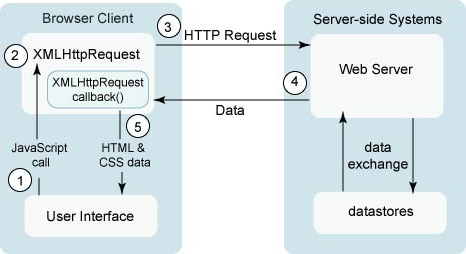Ajax


Promises have three states:
Example: “I promise to post homework 4”
Pending: Not yet posted
Fulfilled: Homework 4 posted
Rejected: Wrong homework posted, or not posted in time
Note, for this class, you do not need to know how to define a promise. This slide is just here to help explain how to define them, as our Ajax Promise code uses them.
var promise = new Promise( function( resolve, reject ) {
// do something uncertain (like make an ajax call)
if ( /* success */ ) {
resolve();
} else {
reject();
}
});
JavaScript
var promise = new Promise( ... promise definition ... );
promise
.then( function( params... ) {
/* Promise resolved -- handle success case */
})
.catch( function( params... ) {
/* Promise rejected -- handle failure case */
});
JavaScript
var url = "my/url/some/file.txt";
var promise = new AjaxGetPromise( url );
promise
.then(handleResponse)
.catch(handleError);
...
...
function handleResponse(responseText) {
/* handle successful ajax request */
}
function handleError(errorMsg, statusCode) {
/* handle error case */
}
JavaScript
A data format that represents data as a set of JavaScript objects invented by JS guru Douglas Crockford of Yahoo! natively supported by all modern browsers (and libraries to support it in old ones)
var myobj = {
fieldName1: value1,
...
fieldName: value
};JavaScript
In JavaScript, you can create a new object without creating a "class"
You can add properties to any object even after it is created:
myobj.field87 = "wubba lubba";JavaScript
var person = {
name: "Philip J. Fry", // string
age: 23, // number
"weight": 172.5, // number
friends: ["Farnsworth", "Hermes", "Zoidberg"], // array
getBeloved: function() { return this.name + " loves Leela"; }
};
alert(person["age"]); // 23
alert(person.weight); // 172.5
alert(person.friends[2])); // Zoidberg
alert(person.getBeloved()); // Philip J. Fry loves Leela
an object can have methods (function properties) that refer to itself as this
can refer to the fields with .fieldName or ["fieldName"] syntax
field names can optionally be put in quotes (e.g. weight above)
document, windowJSON is a way of saving or storing javascript objects. (The technical term is "serializing" which is just a fancy word for turning an object into a savable string of characters)
Browser JSON methods:
JSON.parse( /* JSON string */ ) -- converts JSON string into Javascript objectJSON.stringify( /* Javascript Object */ ) -- converts a Javascript object into JSON textJSON data comes from many sources on the web:
JSON is the de facto universal format for exchange of data
JSON has a few rules that differ from regular JS:
Numerous validators/formatters available, eg JSONLint
JSON can't handle certain data types, so these things just fall out of the object if you try to make JSON strings out of them:
To get Date objects or RegExp objects into your JSON, you could extract them as strings, and then rebuild them from strings.
However, since JSON is ideal for communicating across different types of systems, you can't put Javascript functions in JSON. Other languages wouldn't be able to read JSON effectively if it had Javascript code in it.
(This is also why Dates and RegExps can't go into the JSON object -- other languages wouldn't know how to interpret them for what they are.)
{ // no variable assignment
"first_name": 'Bart', // strings and properties must be quoted
'last_name': "Simpson", // single or double quotes both work
"age" : 13, // numbers can be here without quotes
"cowabunga": true // booleans can be here without quotes
} // no semicolon at the endJSON
Given the JSON data at right, what expressions would produce.
Assume the JSON data is stored in a string var called json.
{
"window": {
"title": "Sample Widget",
"width": 500,
"height": 500
},
"image": {
"src": "images/logo.png",
"coords": [250, 150, 350, 400],
"alignment": "center"
},
"messages": [
{"text": "Save", "offset": [10, 20]},
{"text": "Help", "offset": [ 0, 50]},
{"text": "Quit", "offset": [30, 15]}
],
"debug": "true"
}var data = JSON.parse(json);
var title = data.window.title;
var coord = data.image.coords[2];
var len = data.messages.length;
var y = data.messages[len - 1].offset[1];